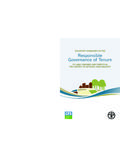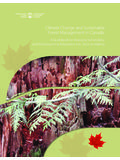Transcription of Province of British Columbia - hspp.ca
1 Province of British Columbia Population: 4,623,0001. Area: 95 million ha Forests: 55 million ha Ownership/allocation of forested lands: Public: 52 million ha (95%). Private: 3 million ha (5%). Public forest land subject to forest management agreements: 22 million ha (timber harvesting land base). Parks and protected areas: million ha or , plus another 14% in special management zones. 1. Description: British Columbia (BC) is on the western coast of Canada, bordering the Pacific Ocean. BC is Canada's most biologically and ecologically diverse Province .
2 The Province 's forests are 91% softwood, giving BC almost half of Canada's softwood inventory. Commercially important species include hemlock, Douglas-fir, balsam, pine, spruce, larch, and cedar. Publicly owned forests account for 95% of BC's forests, with the remaining 5% under private ownership. BC's largest forest product export markets are the United States ( ), China ( ), Japan ( ), and the European Union ( ). Total forest product export sales in 2011. were $ billion2. British Columbia is the world's largest exporter of softwood lumber (2011).
3 2. forest governance : Public lands: About 95 per cent of BC's 55 million hectares of diverse forests are publicly owned, and priorities for the use of these lands are developed through community based strategic land and resource management planning. Comprehensive land use planning involves British Columbians in decisions that determine how public lands will be used today and in the future, and how resources will be managed to benefit current and future generations. The foundation of sustainable forest management in BC is the timber supply review through which BC's independent chief forester is required by law to determine how much wood can be harvested from each of the Province 's 70 management units.
4 This process involves a detailed analysis of 200 year fibre supply projections, public comment and consideration of 1. BCStats, October 2012, 2. Statistics Canada forest governance in the Province of British Columbia non-timber values, and it ensures that the harvest level is based on the latest information, practices and policies economic, environmental and social. About 22 million hectares comprise the timber harvesting land base. Under the forest Act, the government can issue various forms of long and short term tenure agreements (licenses) for Crown timber.
5 The agreement holders can be forest companies, communities, individuals or First Nations. All timber harvesting operations under these agreements, on public lands, must comply with the results-based forest and Range Practices Act. The Act requires that forest stewardship plans document how activities will be consistent with objectives set by government for soils, timber, wildlife, water, fish, biodiversity, recreation resources, visual quality and cultural heritage resources. Before each plan is approved by government, companies must invite and consider public and First Nations comments.
6 The Act also specifies requirements related to activities such as road construction, forest health, and reforestation (silviculture). As per the forest Act, before any logging can begin on public lands, a company must be issued a cutting permit by government, setting out the boundaries of the area approved to be harvested. Timber from both public and private lands is tracked to ensure there is no illegal harvesting and to keep track of payments to government. Possession of unmarked or incorrectly marked timber can lead to fines of up to $500,000 and imprisonment of up to two years.
7 British Columbia is home to many nationally and internationally significant natural and cultural values. Through the establishment of parks, ecological reserves and protected areas, an important first step has been undertaken to ensure that these values are afforded legal protection. The legal framework for protecting these important areas includes the Protected Areas of British Columbia Act, Park Act, Ecological Reserve Act and Environment and Land Use Act. Private lands: About 3 million hectares of BC's forests (5%) are privately owned.
8 Of these 3 million hectares, over 908,000 hectares is classified as Managed forest . Other classifications include forested residential and forested farmland. There are an estimated 20,000 private forest owners in BC. All private Managed Forests must be managed in accordance with the Private Managed forest Land Act and associated Regulations. The regulations specify the required forest practices related to soil conservation, protection of water quality, protection of fish habitat, and reforestation.
9 The Private Managed forest Land Council is an independent provincial agency established under the Private Managed forest Land Act to administer the Managed forest Program and protect key public environmental values on private Managed forest land in BC. This includes the setting and monitoring of forest practices standards, performing audits and enforcing standards. 3. forest management legislation and regulations: Public lands: British Columbia 's sustainable forest management and forest areas are governed by the following BC Acts and Regulations administered by the Ministry of Forests, Lands and Natural Resource Operations.
10 2. forest governance in the Province of British Columbia Primary BC Acts and Regulations governing Crown forest land: forest Act o REGULATIONS: Advertising, Deposits, Disposition And Extension Regulation Allowable Annual Cut Administration Regulation Annual Rent Regulation BC Timber Sales Regulation Community Tenures Regulation Cut Control Regulation First Nations Tenure Regulation forest Accounts Receivable Interest Regulation forest Licence Regulation forest Revenue Audit Regulation Forestry Licence to Cut Regulation Interest Rate under Various Statutes Log Salvage Regulation for the Vancouver Log Salvage District Manufactured forest Products Regulation






